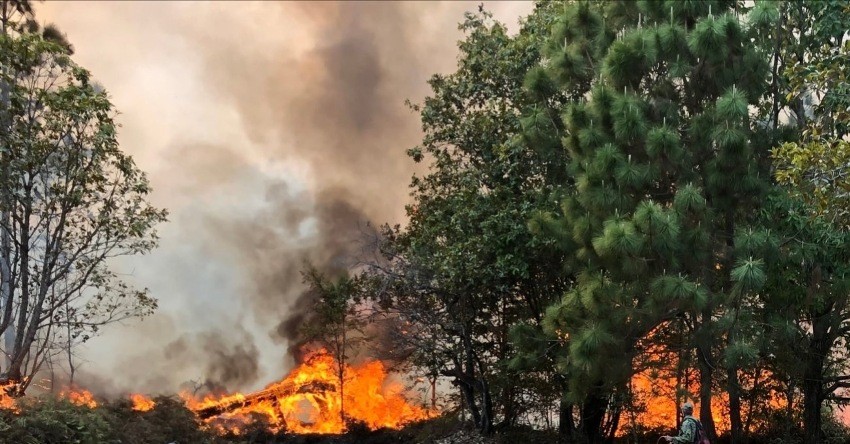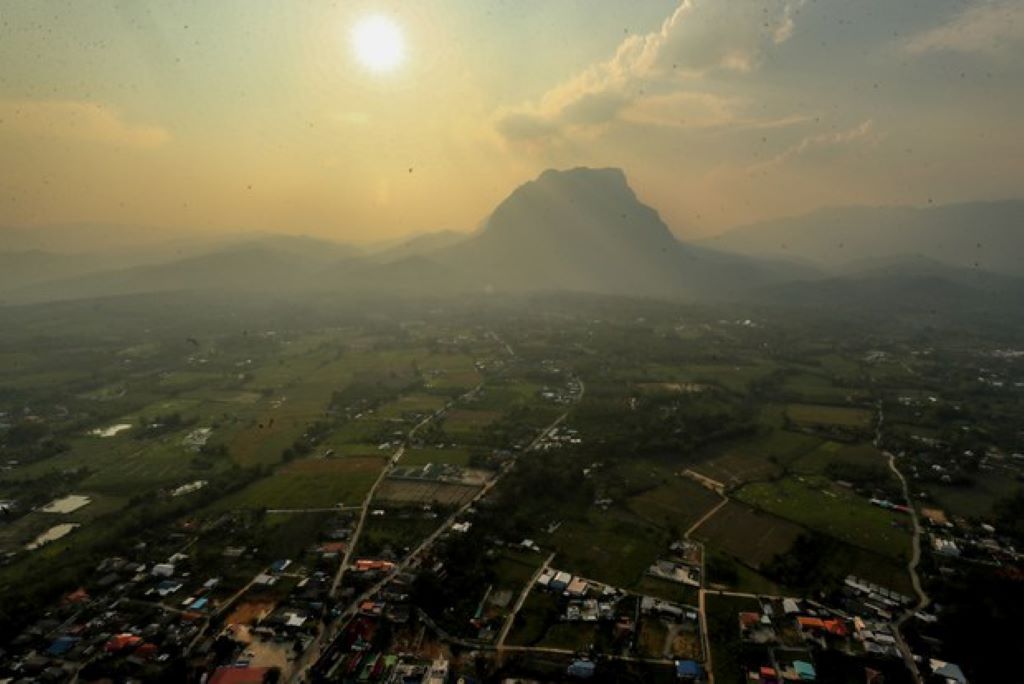Residents in northern Thailand, Laos, and Myanmar’s Shan state have been suffering from the worst haze in years for the past two months. Thousands of people have gone to hospitals with respiratory difficulties, and workers in Chiang Mai, Thailand, which has just been named as one of the most polluting cities in the world, have been urged to stay indoors and work from home.
Out-of-control wildfires and the burning of ever-wider fields of maize stubble after the February harvest to clear land for planting season in May are the two main culprits behind the dangerous pollution, which is 16 times worse than healthy levels in certain locations.
The wildfires are being fueled by drier-than-usual conditions. Many are in difficult-to-reach places, and Thailand’s firefighting efforts are underfunded.
While farmers have cut vast swaths of farmland from the forest to plant corn, primarily for animal feed. Demand for meat is increasing, which means more demand for maize – and higher prices, driving farmers to sow, cultivate, and burn more maize.
“The situation is the culmination of many years of bad agricultural practise,” said Greenpeace food and ecology campaigner Rattanasiri Kittikongnapang. “This is the worst haze in more than 10 years.”
Corn farms are sprouting up all over the place. According to her, between 2015 and 2019, 1.7 million hectares of land were converted from forest to corn production.
Corn Farming in Northern Thailand
The Thai government declared a zero-burn policy in March, but it has yet to be implemented. Bangkok authorities are “hoping it will all go away on its own because they are getting ready for an election,” Rattanasiri said.
Achoo, a Thai farmer with maize fields in Chiang Rai province’s Doi Sa-Ngo hamlet, finds no problem with burning. “It’s normal. “You burn the rest of the harvest after you collect it,” she explained. “Everyone does this, and we have been doing it for years.”
But there are also economic dynamics at work here.
Previously, the majority of the villagers’ crops were vegetables, cassava, pineapple, and edible flowering plants. They have turned to maize in recent years, especially after one of the farmers became a middleman to deliver it to animal feed firms.
“We’re not required to do anything. “Even though we don’t have any money, we get seeds and fertiliser from this person,” Achoo explained. “After the harvest, he collects it from us and takes it to the city.”
The increasing number of so-called hot spots – locations where fires are burning or are likely to ignite – is linked to deforestation and the production of more maize for animal feed. According to Alliya Moun-Ob, an air pollution campaigner for Greenpeace Thailand, rising maize demand is directly related to the rise of the meat sector.
Corn Maize for Animal Feed
Thailand requires at least 8 million tonnes of maize for animal feed, but only generates roughly 5 million tonnes, according to government estimates. It follows that the remainder must be imported.
Thailand established cross-border contract agricultural programmes with farmers in Laos, Myanmar, and Cambodia two decades ago, allowing it to import maize at zero tariffs. According to Alliya, the region has seen an increase in open burning since then.
According to Alliya and other activists, Thailand’s Charoen Pokphand Group, or CP Group, the world’s largest animal feed producer, with an annual production of 27,650 metric tonnes, drives much of the demand for maize.
“The Thai government supports one particular company – CP Group – which is responsible for contract farming maize in the north and neighbouring countries,” Rattanasiri explained.
To persuade rice farmers to switch to corn, CP Group promised to provide interest-free financial assistance and to buy the product at a guaranteed price in a pilot programme announced in December by the Royal Initiative Discovery Institute, a palace project promoting sustainable agriculture in the countryside.
According to Alliya, many farmers “who don’t have any resources or capacity, also don’t have a choice” except to engage in contract maize cultivation. “What is missing in legal and policy-making mechanisms is the liability of industrial sectors linked to environmental impacts while gaining benefits from maize,” Alliya explained.
Increased demand for livestock feed
CP Group claims it is launching a program to trace and verify if its corn maize for feed production is grown in a sustainable manner, particularly in areas that have not been deforested and farms that do not burn the stubble.
A firm executive, Paisarn Kruawongvanich, stated that the company has “always prioritized building a sustainable food production chain while also mitigating transboundary haze pollution.”
Corn prices have risen due to increased demand for livestock feed. According to the US Department of Agriculture Foreign Agricultural Service grain and feed report, local maize prices were 26% higher in February than a year ago, “due to insufficient locally produced maize and uncertainty in the global maize trade.”
Aside from that, wildfires are raging out of control in many parts of the region this year, according to experts, due to the start of the dry season following the end of La Nina, which results in cooler and wetter conditions in parts of Asia due to low sea surface temperatures in the equatorial Pacific Ocean.

Wildfires Raging Out of Control
Air quality in Laos has remained “unhealthy” to “hazardous” for more than four weeks. According to IQAir, the PM2.5 concentration in the capital Vientiane was 150 on Friday, more than 11 times the WHO standard.
Residents in Laos that smoke was flowing from all directions, while experts blamed this year’s fires on open burning and meteorological fluctuations.
“There is little visibility. When we go outside, we must wear masks. My children are becoming ill and have itchy noses and eyes. “It’s like having a cold or flu,” a Vientiane resident told RFA earlier this month.
A doctor at a hospital in Vientiane said they were seeing “a lot of patients with respiratory problems.”
Residents in Tachileik, Myanmar’s Shan state, say that pollution has been affecting them since March 24, saying the haze had previously remained for a couple of days, but this time it was longer and deeper.
According to the ASEAN Specialized Meteorological Centre, or ASMC, El Nino – warmer ocean surface temperatures – brings drier, warmer weather and raises the risk of forest fires and smoke haze in Southeast Asia.
“There was also probably no controlled burning management to keep the forest healthy.” “If you don’t manage it properly, a small fire can quickly become huge and uncontrollable,” warned Prof. Ekbordin Winijkul, dean of the Asian Institute of Technology’s energy, environment, and climate change department.

Fires Purposely Set
Thai officials refused to reveal the alleged causes of the flames, despite the fact that numerous people have been arrested on suspicion of setting the wildfires.
According to activists, the motivations could be to destroy trees in order to construct new farmland or for mushroom hunting. The fire’s devastation provides a nutrient-rich environment suitable to the growth of fungi practically soon afterward, which farmers hunt to harvest and sell in the market.
Experts predict that if nothing is done to mitigate the smog, more people would die.
According to Mushtaq Memon, UNEP Coordinator of Chemicals and Pollution Action for Asia and the Pacific, air pollution was among the top 10 risk factors for death in all Southeast Asian countries in 2019, accounting for over half a million premature deaths.
“Immediate challenges in addressing open burning of crop residues include providing farmers with timely and sufficient resources,” he said.
According to Ekbordin, transboundary haze is “not a problem of one country or one company.”
“We must confront it as a group. If we do not take significant steps immediately, the situation will deteriorate,” he continued. “And it will continue to happen every year.”
⚠ Article Disclaimer
The above article is sponsored content any opinions expressed in this article are those of the author and not necessarily reflect the views of CTN News








